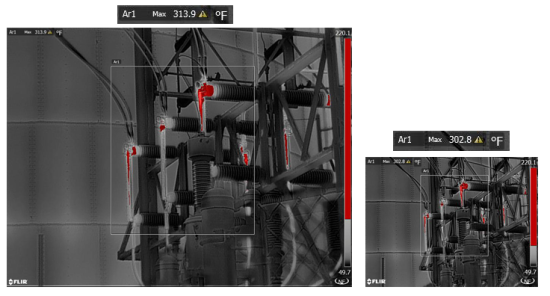This week FLIR quietly introduced a feature that will have a big impact on users of handheld FLIR cameras. UltraMax is an image enhancement technology that captures a series of thermal images and combines the data into one new image. The result is an impressive quadrupling of thermal pixels, including full radiometric measurement data. A 320 x 240 resolution camera using FLIR UltraMax can now produce true 640 x 480 thermal images. (Let that sink in for a moment….) UltraMax is now included on all new FLIR T-Series cameras except the T600, and is available as a paid upgrade for any T-Series camera that uses the Dark Precision menu system (available since March 2014).
Superresolution
UltraMax is a type of superresolution, a technique for combining the information from multiple original images into an image with higher resolution and less noise. It has been widely used in digital photography, and in more recent years has been applied to thermal imaging. (Testo and NEC/Avio also offer superresolution technology on thermal cameras.) While it sounds suspiciously like magic, superresolution is not a simple process of interpolation or pixel averaging. Superresolution uses the natural movement of the human body to capture an image set in which each image is slightly offset from the others. This results in a wealth of data that is much greater than any one image could provide. The data is combined to form an image that includes many more pixels of the target, resulting in a resolution greater than that of the original camera detector. The data is also used to create a clearer image, since pixel noise can be reduced through comparing similar points in multiple images.
How UltraMax Works
FLIR UltraMax captures 16 thermal images in less than one second. These are stored on the camera as a single jpg file, and will appear as one image when viewed on the camera or in software. When downloaded to FLIR Tools, however, the images will include a small symbol in the lower right corner, indicating that the image can be enhanced. After highlighting the image, the user can “Enhance image resolution (UltraMax),” or “Enhance image resolution (UltraMax) and backup original images.” The enhanced image will have twice the original resolution and four times as many pixels. All pixels still include radiometric data, just as with normal FLIR thermal images.
Implications
UltraMax transforms your FLIR camera into that camera you wish you had bought, but couldn’t quite justify. Thermal images will be clearer and larger, allowing better analysis of small details. Because of an increased number of pixels covering the same target area, UltraMax also decreases measurement spot size. This gives greater measurement accuracy to particularly small details. Even digital zoom seems more appealing, since at 2x zoom on an UltraMax image, the user would still have the same resolution as the camera has natively.
UltraMax effectively moves an infrared camera up one imaging class. For instance, a FLIR T420 has a resolution of 320 x 240, yielding 76,800 total pixels. An UltraMax image from the T420 will have a resolution of 640 x 480, for a total of 307,200 pixels. The visual difference between the two is astounding; a 640 x 480 image has so much detail that most objects are crisp and readily identifiable to the human eye. Looking at the numbers a different way, consider that the FLIR T420 currently costs $8750. Even without UltraMax it’s a great camera with a great picture. But add in UltraMax, and the T420 can produce images similar to those of the FLIR T620, a camera costing $20,950. Before we weep for the T620 though, just consider that it too is equipped with UltraMax–resulting in an eye-popping 1280 x 960 resolution for a full 1.2 mega pixels.
Limitations
There are some conditions in which UltraMax will not be able to enhance an image. Too much movement from the user or the target while the images are being captured will result in an image set that cannot be aligned. Similarly, if the thermal camera is mounted on a tripod, it will have too little movement, and the images will not have the necessary offset. FLIR recommends simply holding the camera steady with two hands when capturing the images. A scene with uniformly low contrast, or images being out of focus may also impede the enhancement process. UltraMax can be toggled on or off as desired from within the camera settings menu.
Final Thoughts
FLIR UltraMax offers impressive added value to anyone who has recently purchased or is considering buying a FLIR T-Series camera. Doubling infrared resolution has always been an expensive proposition, doubling or tripling camera cost. Yet with UltraMax, users have double the resolution at no increase in price. Though only available after downloading to a PC, and not in the camera itself, UltraMax nonetheless gives users the ability to see twice as much information in each image. And when you consider that cameras like the FLIR T640 will now create thermal images in full HD, it sure looks as though UltraMax may be unlocking the future of infrared.
Thoughts or questions about FLIR UltraMax? We would love to hear what you have to say. You can give us a call at (877) 273-2311, send us an email at [email protected], or simply add a comment below.



Pingback: Hidden Upgrades to FLIR T-Series Cameras | Ivy Tools Blog
It is not available as a paid upgrade for any T-Series camera because i have asked for my T440 and it is to old.
Quite right – it is only available on cameras newer than about March/April 2014. UltraMax is added through a firmware update, but is only compatible with FLIT T-Series cameras running the newer “Dark Precision” menu system.